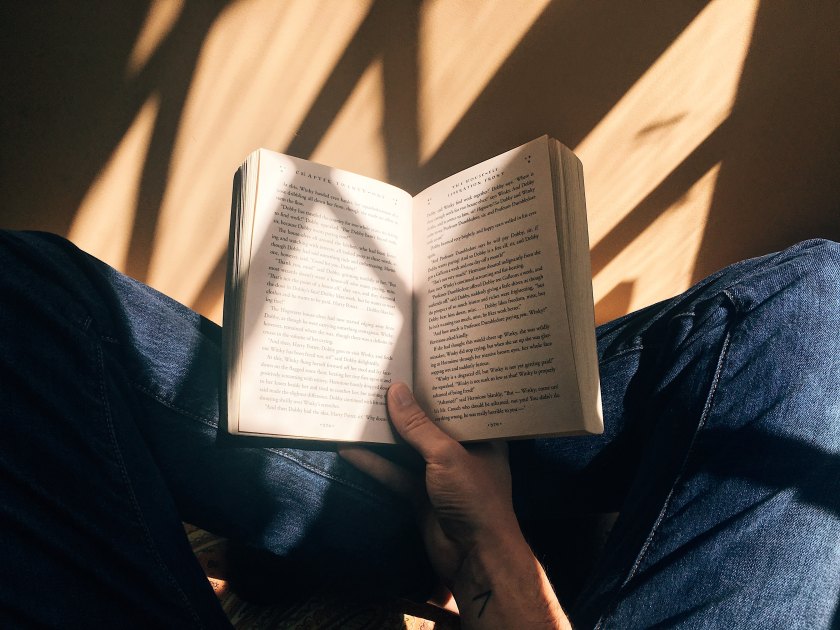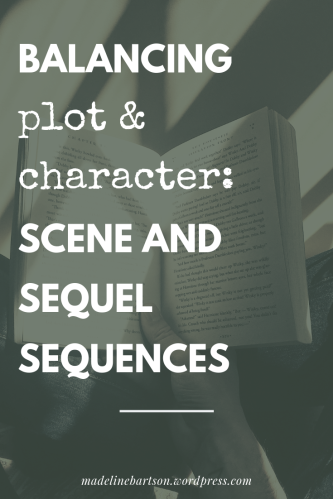
The four-act plot structure is great for constructing a solid plot on a macro-level, but it leaves a lot of room for a story to still fall flat. How do you move between four-act structure’s plot points while creating forward momentum, conflict, tension, and character growth on a micro-level?*
*Okay, so this is probably a rhetorical question you’ve never asked yourself, but roll with me here.
After I learned four-act structure, I thought I had unlocked the key to the storytelling universe. So this is how authors have been writing awesome books. All I had to do was follow the formula and *bam* instant bestseller, right? Nope.
You can create a tight and page-turning plot by moving even DEEPER below four-act structure. That’s when Scene and Sequel Sequences come in.
The unit of a Scene and Sequel Sequence moves your story forwards, making your main character (MC) proactive. She’s no longer meandering around out of your control while the plot just happens to her. A Scene (action) followed up by a Sequel (character reaction) is how you create a balance of plot and character.
Not to be melodramatic or anything but … *prepares to be melodramatic* Scene and Sequel Sequences changed my life. Or, my writing life. Okay, my story. But you get the point. It’s a game changer! If you want to create a story with momentum and a character with drive, this micro-level stuff is important to know. Let’s get started.

WHAT ARE SCENES & SEQUELS?
For clarity, I’m going to refer to uppercase SCENES and SEQUELS the rest of this post. For all intents and purposes, let’s chuck everything else you know about lowercase-s “scene” and “sequels” out the window right now.

So, SCENES and SEQUELS are each made up 3 parts for a total of 6 beats in one SCENE and SEQUEL Sequence.
The more plot-driven SCENE:
- Goal — What does your main character want to accomplish right now? Ultimately, this will get them closer to their BIG story goal. The goal of a SCENE can be a passive goal (hide from the bad guys) or an active goal (hunt down the villain). Keep in mind what every character (not just the MC) wants, because that will help create …
- Conflict — What obstacles are in the MC’s way? This includes internal AND external conflict. For extra conflict brownie points, put the characters up against each other.
- Disaster — The MC either a) gets what she wants and realizes that’s not what she really wanted or b) doesn’t get she wants. Either way, the SCENE ends with a setback.
The more character-driven SEQUEL:
- Reaction — The MC reacts to this disaster. There’s usually an external reaction, but for maximum effect, show us the MC’s internal reaction as well.
- Dilemma — The MC asks “now what?” and weighs the pros and cons of every decision.
- Decision — The MC picks the next best course of action, which becomes the new goal for the next SCENE.
You with me so far?

HOW TO CREATE A SEQUENCE
The SCENE is followed by a SEQUEL, and after the SEQUEL a new SCENE begins. The SCENE Goal always comes from the Decision made at the end of the SEQUEL.
Here’s an example of how all of this comes together:
- Goal — Daisy wants to take and ace her AP Chem final. This will secure her title as Valedictorian and help her achieve her ultimate story goal of getting into her over-bearing mom’s alumni Ivy League school.
- Conflict — Daisy notices her Valedictorian rival, Steve, keeps staring at her AP Chemistry test, and Daisy suspects he’s cheating off of her. Despite multiple attempts to shield her test from him, Steve doesn’t relent. Daisy hisses a few choice words at him.
- Disaster — Her Chemistry teacher hears Daisy talking, accuses her of cheating, and sends her to the principal’s office.
- Reaction — Her external reaction is to walk numbly out of the classroom. Her internal reaction is to instantly beat herself up, imagine all the ways the scenario could have gone differently, hiss several more choice words about Steve, and anxiously fear having to explain this to her Mom.
- Dilemma — Is it possible to hide this from her mom? Should she even go to the principal’s office?? Should she give up the fight for Valedictorian? Should she take this matter to the PTA board?
- Decision — Daisy decides that she’s not going to tell her mother. Instead, she’s going to try and smooth things over with the principal, whom she’s always been on good terms with.
- Goal (of the next SCENE and SEQUEL Sequence) — Convince the principal that she wasn’t cheating and that her Chem teacher wrongfully accused her.
PACING SCENES & SEQUELS
All right, so this structure is a bit formulaic, right? But here’s where things get fun: You don’t have to show every beat of every SCENE and you don’t have to show every beat of every SEQUEL. In fact, sometimes you can completely skip over a SCENE or SEQUEL. Playing around with this balance is how you blend together action (SCENES) with character building (SEQUELS).
The SCENE and SEQUEL Sequence creates a solid cycle of action and reaction that gives your story momentum and character growth. Playing around with the cycle results in a more dynamic story pace and a beautiful combination of plot and character.
If you want to kick the pacing up several notches, focus in on the SCENE. Goal, Conflict, Disaster. Goal, Conflict, Disaster. Goal, Conflict, Disaster. When it comes to the SEQUEL, you can either a) take it out completely or b) sum up the SEQUEL in a few paragraphs, or even a few sentences.
If you want to slow down the pacing, you can shorten the SCENE. It is, however, unwise to completely throw out the SCENE. When too many SCENES are removed or breezed over, the plot starts happening to the MC. Things get a little too slow.
You have to know the rules to break them. As a writer, it’s extremely helpful to understand these beats — EVEN if you don’t show every single step of the SCENE and SEQUEL Sequence.

FAQ ABOUT SCENE & SEQUEL SEQUENCES
When I started using this technique, it left me with a ton of questions. And honestly, it took me quite a few years to learn the answers. So I thought I’d sum up what confused me about this technique and what I’ve learned.
Here’s what I struggled the most with when it came to understanding and using this technique.
01. Where do scenes fit in?
SCENES and SEQUELS can happen within one scene, their own scenes respectively, or multiple scenes.
Okay, that was a mouthful. Let’s go back to the Daisy example.
For the SCENE, we could use multiple scenes (lowercase-s!). Maybe we show Daisy riding the bus to school and going over her flashcards. Scene break. Now we show Daisy walking to her locker, but not before Steve can taunt her. Scene break. Now we show Daisy in AP Chem. Scene break.
Scene (lowercase-s) breaks are a great pacing tool. They let you cut to the important stuff without saying “Daisy drove 15 minutes to school, walked through the front doors, walked to her locker, grabbed her books, walked into chem, sat down, took the test yada yada yada.”
But, let’s say the stakes for Daisy are even HIGHER than Valedictorian. Maybe she has a scholarship riding on this exam. To increase the tension, we could draw out every single move until she takes the test. We could get rid of scene breaks entirely. This draws up the anticipation and cranks up the tension.
Personally: For the sake of simplicity, when plotting out my SCENE and SEQUEL Sequences, I make each SCENE a scene and each SEQUEL a scene. I use Scrivener to plot and write, so I make each SCENE its own notecard and each SEQUEL its own notecard. I do this even if I anticipate the SEQUEL to be only a few sentences. This way, I can connect ALL the dots in my story, even if I later choose not to reveal every single dot.
During revisions, I think about breaking up or combining SCENES and SEQUELS into scenes. Eventually, I lump these scenes into chapters.

02. What about chapters?
When it comes to SCENE and SEQUEL Sequence, chapters serve the same function as scenes. You can have as many (or as few) SCENES and SEQUELS in a chapter as you want. This is the more artistic and intuitive side of writing where there’s no hard or fast rule. Follow your storyteller gut.
Personally: When I’m finished, a chapter usually holds between one to two SCENE and SEQUEL Sequences. For reference, my chapters are around 3k.
03. Do you seriously need the whole shebang of goal, conflict, disaster, reaction, dilemma, decision?
Nope.
If you want to focus more on plot, include longer SCENES and shorter SEQUENCES.
If you want to focus more on characters, shorten your SCENES and lengthen your SEQUENCES.
Personally: Again, I like to plot out every single SCENE and SEQUEL so I have a logical sequence of plot and character. However, I don’t include every single SCENE and SEQUEL when it comes to actual drafting, revising, and editing. I’m a huge outliner, and this is just works best for me. Remember: half the battle of writing is figuring out what process works best for you.
05. How do you move the story forward instead of in a circle?
You want your character to get CLOSER or FURTHER from their story goal.
If Daisy simply had to retake her Chem test, she’d be in the same place. If Daisy decided she’d write an extra credit paper for Chem, she’d be pretty much in the same place — fixated on passing Chem and securing Valedictorian.
When Daisy makes the decision to petition to the PTA board or hide this from her mother or sabotage Steve, her goals are progressing and changing. Growing.
The SCENE and SEQUEL sequence can get cyclical if you don’t watch out. But remember, it’s a sequence, not a cycle. Focus on intentionally moving the story FORWARD, whether your plot is rolling or your characters are growing.
Today’s post was a little bit technical, but I had so much fun writing about it! I think craft posts can tend to get a little dry and jargon-y, and I want to put an end to that. Writing is fun, and so is learning about craft. You don’t have be a super serious writer to learn more about stories, and I just want to spread the storyteller love. 💛
If you want to learn more about Scene & Sequel Structure, I’d HIGHLY recommend:
- Techniques of the Selling Writer — such a great writing book in general
- Writing the Perfect Scene — this was my very first introduction to Scene & Sequel Structure 🙂

Have you ever heard of Scene & Sequel Structure? Do you have a go-to tip for creating killer scenes? Do you tend to lean towards stories that are heavier in plot or character?
Do you have any questions for me? I’d love to answer them!

